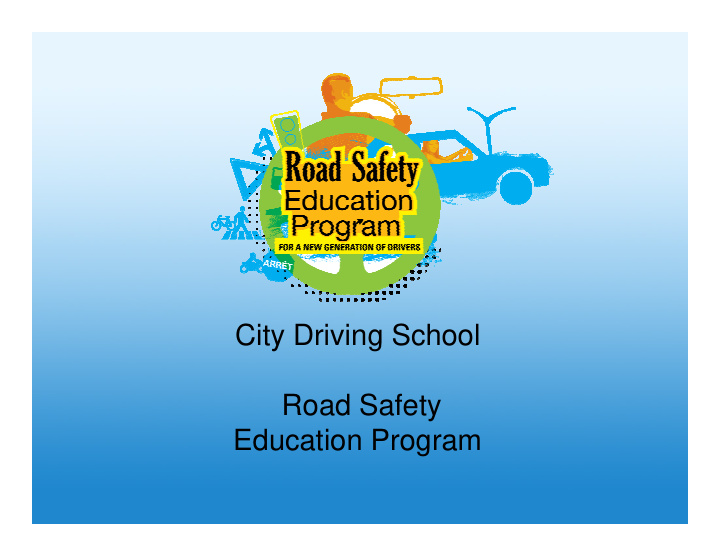



City Driving School Road Safety Education Program
Goals of the Presentation • To provide an overview of the Road Safety Education Program, i.e. the competencies to acquire and the guiding principles • To present the course structure and the learner’s progress through it • To explain the pedagogical approach used in class and on the road • To present the learning material and the dedicated Website for the program 2
Competency-Based Approach 4 Competencies to Acquire • To establish the profile of a safe, cooperative and responsible driver • To handle a passenger vehicle • To share the road • To use the road network independently and responsibly 3
Guiding Principles 1. Alternation Between Theory and Practice 2. Independent Driving 3. OEA Driving Strategy: Observe-Evaluate-Act 3. OEA Driving Strategy: Observe-Evaluate-Act 4. Eco-Driving 5. At-Risk Behaviours: alcohol, drugs, fatigue, speeding, non-wearing of seat belts, distractions, etc. 4
1. Alternation Between Theory and Practice • The knowledge and skills acquired in class are gradually put into practice in in-car sessions • Formative evaluations throughout the process provide a picture of the learner’s progress and shed light on his or picture of the learner’s progress and shed light on his or her strengths and weaknesses • The SAAQ’s knowledge test and road test are taken at the end of the learning period (at least 10 and 12 months, respectively, after a learner’s licence has been obtained) 5
2. Independent Driving • The change from a learner’s licence to a probationary licence often marks a critical stage for new drivers Learner’s licence Probationary licence 2.8 accidents 38 accidents per 1000 licence holders per 1000 licence holders • Independent driving places learner drivers in driving situations in which they must make their own choices, in a way that leads to the right decisions and makes them feel responsible for their driving when they are alone behind the wheel 6
3. OEA Driving Strategy • The learner is encouraged to apply the OEA strategy while learning to drive • The strategy promotes – Observation and quick evaluation of the environment – Observation and quick evaluation of the environment – Better anticipation of dangerous situations – Safe, cooperative and responsible behaviour around all types of road users, particularly vulnerable users (pedestrians, cyclists, etc.) 7
4. Eco-Driving • The learner is encouraged to apply eco-driving – In trip choices – In trip planning – In driving manoeuvres – In driving manoeuvres • Eco-driving has advantages for – the environment: less greenhouse gas – road safety: attitudes that contribute to safe and responsible driving 8
5. At-Risk Behaviours • The learner is made aware of the significant roles played by speeding, alcohol, drugs, fatigue and non-wearing of seat belts in the occurrence and seriousness of accidents seriousness of accidents 9
Course Structure 10
11
12-Month Timeline (learner’s licence period) Phase 1 Phase 2 Phase 3 Phase 4 Attestation of successful completion of Phase 1 SAAQ SAAQ SAAQ Learner’s Licence Knowledge Test Road Test Minimum of 10 months No attestation required Completion of all theoretical instruction Minimum of 12 months Attestation of successful completion of the driving course (theory and practice) Passage of the knowledge test 12
An Interactive Approach • The learner is at the heart of the learning process • Learners work in teams to stimulate reflection and awareness regarding their tendencies, skills and awareness regarding their tendencies, skills and behaviours, in general and on the road • The instructor guides the participants through the learning process by listening, questioning, correcting and providing missing information 13
Theoretical Instruction • 12 classroom modules, each lasting 2 hours • Work in teams, preferably groups of three, on an activity related to the program competencies competencies • Presentation of theoretical content by an instructor/monitor on a variety of topics related to road safety 14
Practical Instruction • 15 in-car on-road sessions, each lasting 50 minutes • Briefing with the instructor (5 minutes) before going on the road road • Debriefing with the instructor (5 minutes) once back off the road • Self-evaluation by the learner of his or her strengths and weaknesses 15
Self-Learning • Homework using the following documents: – Road Access Binder – Driver’s Handbook – Driving a Passenger Vehicle – Any other material handed out by the driving school – CityDrivingSchoolMontreal • Driver Safety Education Program Website for the review exercises 16
Road Access Binder Road Access Binder • The Road Access Binder has information complementary to the theoretical instruction given in class for each module • It includes a supplement to Driving a Passenger Vehicle and the Driver’s Handbook • A number of questions in the knowledge test are taken from the supplement 17
Driving a Passenger Vehicle • Basic manoeuvres for controlling the vehicle • More complex driving techniques for difficult conditions conditions • A visual exploration method • Fuel-efficiency tips • Exercises to evaluate your knowledge A number of questions in the knowledge test are taken from this book 18
Accompanying Rider’s Guide • Advice for the accompanying rider and practical exercises to help the learner acquire driving experience in a variety of experience in a variety of situations 19
Recommend
More recommend